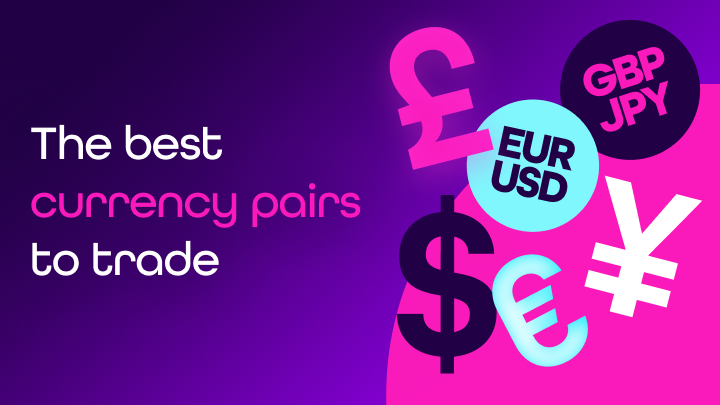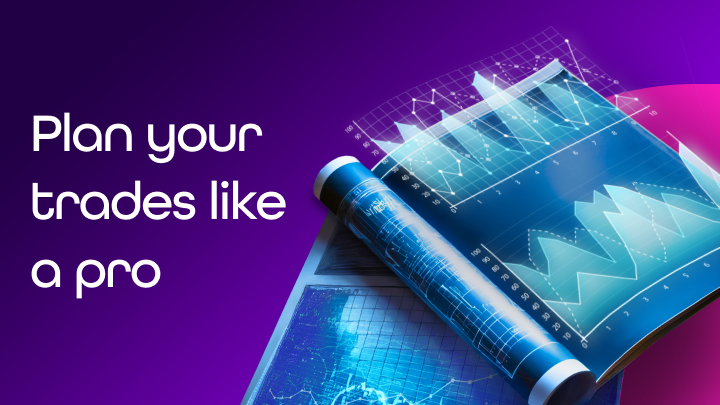Best currency pairs to trade: What to choose and why
Want to know which currency pair is actually worth trading? It’s not just about what’s trending – it’s about what fits your style. In this article, we’ll dive into the best currency pairs for beginners and more experienced traders, highlight the most volatile ones, and help you choose a pair you can grow with.

What’s the best currency to trade?
Maybe you’ve seen abbreviations like EUR/USD or USD/JPY and thought: “OK, two currencies. But now what?” The truth? These currency pairs are the core of the forex market – the largest financial market in the world, where over 7 trillion dollars change hands every single day. Yeah, you read that right – trillions.
But here’s the catch – not all currency pairs are the same.
Some move like snails, others like Formula 1 in a sharp turn.
Some are super stable – perfect for calm swing trades.
Others will teach you risk management real fast.
That’s why it’s important to understand how currency pairs work, what types exist, and most importantly – how to choose the one that fits your trading style.
What is a currency pair and how does it work?
In forex, currencies are never traded individually – always in pairs. Every currency pair consists of two parts:
- Base currency – the first one listed
- Quote currency – the second one
Example: EUR/USD = 1.10 means 1 euro equals 1.10 US dollars.
Types of currency pairs
Not all pairs are created equal. There are three main categories:
Major currency pairs
- The most traded and most liquid
- Low spreads = lower trading costs
Examples:
- EUR/USD (euro / US dollar)
- USD/JPY (US dollar / Japanese yen)
- GBP/USD (British pound / US dollar)
- USD/CHF (US dollar / Swiss franc)
- USD/CAD, AUD/USD, NZD/USD
Perfect for beginners – stable, predictable, and available 24/5.
Minor currency pairs
- Pairs without the US dollar but with other strong currencies
- Examples: EUR/GBP, EUR/JPY, GBP/JPY
- Lower liquidity, higher spread = higher cost
Want more action? Try these. But watch out for sudden swings.
Exotic currency pairs
- Combo of a strong currency and one from an emerging economy
- Examples: USD/TRY (US dollar / Turkish lira), EUR/CZK (euro / Czech koruna)
- High spread, higher risk – but also higher profit potential
For more advanced traders with solid nerves and good money management.
Best currencies to trade for beginners
When you’re just starting out, you need something that won’t knock you out of the game right away. Something stable, easy to read, and with a low spread. That’s exactly why most newbies start with major currency pairs. Here’s the top 5 forex pairs that’ll have your back from day one:
EUR/USD
- Most traded currency pair in the world
- Super low spread, massive liquidity
- Smooth, stable movements – great for learning technical analysis
- Reacts to EU and US news (like ECB rate decisions or US NFP data)
Why we love it:
✅ Easy to predict
✅ Tons of educational content available
✅ Lower trading costs
GBP/USD
- More volatile than EUR/USD
- Great for scalping and day trading
- Heavily influenced by UK and US news
Why you’ll enjoy it:
🚀 Bigger moves = bigger profit potential
⚠️ But also bigger risk – trade with caution
USD/JPY
- Combines the US dollar and Japanese yen
- Heavily traded during the Asian and US sessions
- Often used in carry trade strategies
💡 Fun fact:
This pair is highly sensitive to market sentiment – if something big happens in the world, USD/JPY usually reacts first.
USD/CHF
- Known as the “Swissie”
- The Swiss franc is considered a “safe haven” currency
- Low volatility = less stress, better for swing strategies
✅ Great choice if you prefer stability over drama.
AUD/USD
- Reacts to commodity prices (gold, iron, coal)
- Strongly connected to the Chinese economy
- Ideal for macro-focused traders
💡 Fun fact:
When China’s economy grows, the Aussie usually follows.
Most volatile currency pairs
Volatility = movement. And movement = opportunity for profit. (Or loss. Let’s be real.)
Volatile currency pairs are perfect for scalpers, day traders, or anyone who wants to squeeze quick action out of the markets. But heads up – these pairs don’t play nice. They won’t give you anything for free.
What makes a pair volatile?
- Big macroeconomic events (inflation, interest rate decisions…)
- Political instability news (think Brexit-level drama)
- Low liquidity or exotic currencies
GBP/JPY
- Wild swings – we’re talking dozens or even hundreds of pips a day
- Influenced by both the British and Japanese economies
- Ideal for experienced traders who know how to manage risk
Why trade it?
- Pure action
- Definitely not for beginners
USD/TRY
- Super high volatility thanks to political and economic chaos in Turkey
- Big spikes driven by inflation, central bank moves, etc.
- Huge swap rates – good for carry trade if you know what you’re doing
USD/MXN
- Mexico’s economy is closely tied to the US and oil prices
- Often reacts to news from the Fed, Trump-era politics, or Latin America
- Traders love this pair for its balance between trending moves and surprises
NZD/JPY
- Both currencies are sensitive to global sentiment and commodity prices
- A great pair for swing trading
- Volatility is often underrated – which makes it even more interesting
EUR/TRY or EUR/ZAR
- Low liquidity = higher spread
- Massive daily moves – but also massive risk
- For advanced traders who can blend technicals and fundamentals
How to survive volatile pairs?
✅ Always use a stop-loss
✅ Trade smaller position sizes
✅ Watch the economic calendar (central banks, NFP, CPI, etc.)
How to choose the right currency pair for your trading style
Every trader is different. Some crave action, others prefer calm. Some hold trades for minutes, others for days. That’s exactly why you should choose a currency pair that matches your personality, schedule, and strategy.
Are you a scalper? You need speed
Do you trade on 1-minute to 15-minute charts? Go for just a few pips and hold trades for a few minutes max? You need tight spreads and high liquidity.
Best pairs:
- EUR/USD
- GBP/USD
- USD/JPY
- AUD/USD
💡 TIP: Focus on active sessions – the best moves happen during the London and New York overlap.
Are you a day trader? You need volatility and structure
Do you open and close trades during the same day (no overnight holding)? Look for clean structures, breakouts, and retests of support/resistance?
Best pairs:
- GBP/JPY
- USD/CAD
- EUR/JPY
- AUD/JPY
💡 Tip:
Watch the economic calendar – big intraday moves often come after key news (NFP, CPI, central bank meetings…).
Are you a swing trader? You need trend and peace
Hold positions for 1–5 days (sometimes longer)? You’re looking for strong trends and clean technical setups?
Best pairs:
- NZD/JPY
- USD/CHF
- EUR/GBP
- AUD/USD
💡 TIP: Look for trending pairs on H4 or D1 charts and back them up with fundamentals.
Into carry trading? You care about interest rates
Looking to earn from interest rate differentials between two currencies? You’ll need a pair with a clear interest rate gap and a longer-term outlook.
Best pairs:
- AUD/JPY
- NZD/JPY
- USD/TRY
💡 Tip:
Keep an eye on central bank policies – rate hikes and cuts are your bread and butter here.
Top 5 most traded currency pairs
You know what makes a good currency pair? The whole world trades it. The more people in the market, the more liquidity, the lower the spread, and the better the trading conditions for you.
Here are the top 5 most traded forex pairs every trader should know:
| Currency pair | Nickname | Key strengths | Best for |
|---|---|---|---|
| EUR/USD | Fibre | Most liquid, low spread, great for beginners | All styles (scalp to swing) |
| USD/JPY | Gopher | Reacts to global sentiment, clean technicals | Day trading, swing |
| GBP/USD | Cable | High volatility, big moves | Scalping, day trading |
| USD/CHF | Swissie | Stable, safe, calm | Swing, long-term |
| AUD/USD | Aussie | Linked to commodities & China, trending behavior | Swing, day trading |
What to take away from this?
- A currency pair is always made of two currencies – a base and a quote.
- There are major, minor, and exotic currency pairs.
- For beginners, major pairs like EUR/USD or USD/JPY are ideal.
- Volatile pairs (e.g., GBP/JPY, USD/TRY) bring fast moves – and fast risks.
- Choose pairs based on your trading style – scalping, swing, or long-term.
- Most traded pairs are liquid, stable, and easier to analyze.
What’s next?
- Keep an eye on the economic calendar – it moves the markets.
- Practice on a demo trading account before risking real money.
- Learn technical and fundamental analysis – not just one or the other.
- Focus on 1–2 pairs that fit your style and time availability.


